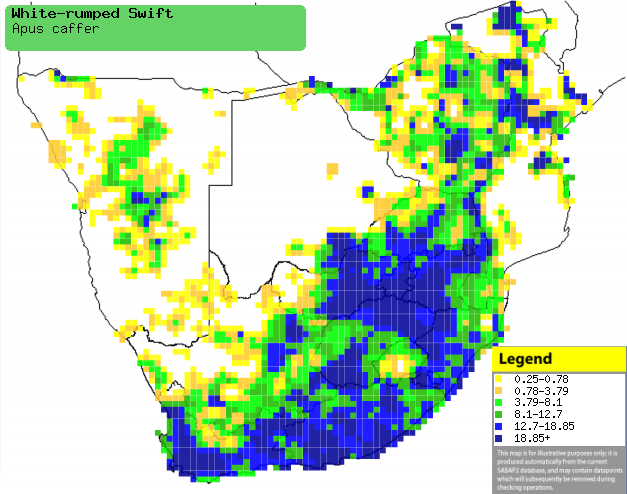|
Apus caffer (White-rumped swift)
Witkruiswindswael [Afrikaans]; Ihlabankomo, Ihlankomo
(generic names for swifts) [Xhosa]; uNonqane [Zulu]; Sisampamema (generic term
for swallows, martins, swifts and spinetails) [Kwangali]; Lehaqasi (generic term
for swifts) [South Sotho]; Nkonjana (generic term for swift) [Tsonga]; Pêolwane,
Phêtla (generic terms for swifts, martins and swallows) [Tswana];
kaffergierzwaluw [Dutch]; Martinet cafre [French]; Weißbürzelsegler [German];
Andorinhão-cafre [Portuguese]
Life
> Eukaryotes >
Opisthokonta
> Metazoa (animals) >
Bilateria >
Deuterostomia > Chordata >
Craniata > Vertebrata (vertebrates) > Gnathostomata (jawed
vertebrates) > Teleostomi (teleost fish) > Osteichthyes (bony fish) > Class:
Sarcopterygii (lobe-finned
fish) > Stegocephalia (terrestrial
vertebrates) > Tetrapoda
(four-legged vertebrates) > Reptiliomorpha > Amniota >
Reptilia (reptiles) >
Romeriida > Diapsida > Archosauromorpha > Archosauria >
Dinosauria
(dinosaurs) > Saurischia > Theropoda (bipedal predatory dinosaurs) >
Coelurosauria > Maniraptora > Aves (birds) > Order: Apodiformes >
Family: Apodidae
The White-rumped swift is widespread and common, occurring
across sub-Saharan Africa. It often forages in mixed species flocks, usually
over savanna, forest, grassland or shrubland, eating mainly termite alates. It
usually steals the nests of other swifts and swallows, aggressively chasing the
breeding pair away, before evicting any chicks or eggs present in the nest. The
female actually lays multiple clutches of 1-5 eggs in one breeding season,
waiting only a week after the chicks have fledged before laying another clutch.
This process, known as multi-brooding, is part of the reason that this species
is so common, as it means that one female can produce dozens of chicks annually.
Distribution and habitat
Occurs from south-western Europe to
Africa, excluding the Sahara and large parts of the DRC, Angola
and Tanzania. In southern Africa it is common in Namibia, south-eastern
Botswana, Zimbabwe, Swaziland and South Africa. As it spends a
large portion of its life in the air, it is not picky about what habitats it
forages over, however it generally prefers savanna, forest, grassland and
shrubland.
|
 |
|
Distribution of White-rumped swift in southern Africa,
based on statistical smoothing of the records from first SA Bird Atlas
Project (©
Animal Demography unit, University of
Cape Town; smoothing by Birgit Erni and Francesca Little). Colours range
from dark blue (most common) through to yellow (least common).
See here for the latest distribution
from the SABAP2. |
Movements and migrations
Breeding migrant, arriving in southern Africa around
August-October, going through its full breeding cycle before departing in the
period from April-May.
Food
It exclusively eats insects, typically foraging aerially in mixed species flocks, along with
other swift and swallow species. The following food items have been recorded in
its diet:
Breeding
- It does not usually make its own nest, instead it
steals the nests of other swifts and swallows, especially
Little swift and
South African cliff-swallow but also the
Greater-striped,
Lesser-striped,
Wire-tailed and
Red-breasted swallows. It is extremely vicious and aggressive, evicting
breeding swallows from their active nests, harassing the breeding pair
before throwing out any chicks or eggs. It occasionally builds its own nest,
which is a flat platform of feathers glued together with saliva, typically
placed in a rock crevice, cliff or building.
- Egg-laying season is from August-April, peaking from September-January.
- It lays 1-5 eggs, which are incubated by both sexes for 21-25 days. The
female actually lays multiple clutches in one breeding season, waiting only
a week after the chicks have fledged before laying another clutch. This
process, known as multi-brooding, is important factor of why this species is
so common, as it means that one female can produce dozens of chicks
annually.
- The chicks are brooded for the first three weeks of their lives, leaving
the nest and becoming independent at about 35-53 days old.
Threats
Not threatened, in fact extremely common and widespread.
References
-
Hockey PAR, Dean WRJ and Ryan PG 2005. Roberts
- Birds of southern Africa, VIIth ed. The Trustees of the John Voelcker
Bird Book Fund, Cape Town.
|
